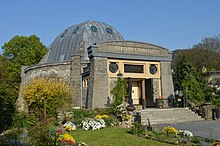Nibelungen Hall (Königswinter)
The Nibelungenhalle is a domed building in Königswinter , a town in the Rhein-Sieg district in North Rhine-Westphalia . It is on the way to the summit of the Drachenfels , where Siegfried is said to have killed the dragon, and shows a collection of paintings by Hermann Hendrich for Richard Wagner's opera cycle The Ring of the Nibelung and Wagner's Grail opera Parsifal . The hall includes a "dragon cave" and a reptile zoo outside.
The Nibelungenhalle stands as a monument under monument protection .
history
The Nibelungenhalle was opened in 1913 on the 100th birthday of Richard Wagner. The idea for the dome building came from Hermann Hendrich and was implemented by the Berlin architects Hans Meier and Werner Behrendt. The building is attributed to the late Art Nouveau . In 1933 the "Dragon Cave" was built in the outside area of the hall, and in 1958 the reptile zoo was added. The Nibelungenhalle was undergoing extensive restoration and renovation from 2013 to 2015.
Hall
Entrance area
To the left and right of the monolith above the entrance, the corner pillars bear half-reliefs with dwarfs who process the Nibelung gold. A curtain in the entrance area, designed by August Wilckens , shows three norns on the world ash Yggdrasil spinning the “threads of fate”. The dragon eats the roots of the tree - symbol of the downfall of the world of gods.
inner space

In the interior of the hall there are six pillars that support the dome. A representation of the cosmos can be seen on the floor, which is made of xylolite . A disk of the earth located in the center is enclosed by a hexagram . The hexagram consists of two triangles, symbols for water and fire. The 60-meter-long Midgard Serpent winds around the earth's disk .
In the center of the room there is a bronze Hendrich bust by Heinrich Splieth on a pedestal .
In the six niches in the hall there are twelve large paintings interpreting the opera cycle Der Ring des Nibelungen with its four stage works Das Rheingold , Die Walküre , Siegfried and Götterdämmerung . The apse with the consecration stone made from Drachenfels trachyte stone is decorated with paintings that were originally in the Hall Deutscher Sagenring in Burg an der Wupper . On the consecration stone there is a Wagner relief and the inscription "Honor your German Masters" from Wagner's Die Meistersinger von Nürnberg .
On the way through the hall, the visitor is accompanied by music from Wagner's Der Ring des Nibelungen .
Rehabilitation of structural damage
The Nibelungenhalle has suffered structural damage in numerous places over the years. The dome roof was leaking. Originally it was supposed to be clad with copper, but the financial means were lacking when the hall was built. The floodlights installed in the roof for the paintings and twelve discs with the signs of the zodiac in the dome were damaged and could not initially be restored. Paintings also needed restoration because they suffered from the water that penetrated through the leaks in the roof.
The renovation of the hall began in 2013 with the first construction phase. The federal government and monument protection institutions are paying around 450,000 euros for this. In a first step, the roof of the self-supporting concrete dome was renovated. This was followed by the interior of the dome, the twelve double windows and the atria above the paintings.
In the summer of 2015, the work was successfully completed with the insertion of twelve new panes with signs of the zodiac, the installation of the extensively restored door and the complete modernization of the entrance area.
Views of the hall
Hermann Hendrich : Freya's garden
Outdoor area
In the outside area of the hall, the Königswinter architect and sculptor Franz Josef Krings designed the heads of the gods Wotan and Loki , the giants Fasolt and Fafner and the Nibelung heroes Hagen and Siegfried in an axially symmetrical arrangement as half-relief sculptures .
In the “dragon's cave” a corridor leads to a walled place, which is now surrounded by ivy , where a 13 m long, moss-covered concrete dragon lies, which was also created in 1933 by Krings.
In the reptile zoo, there are living animals from North and South America, Australia, India, Indonesia, Africa, Madagascar, Papua New Guinea and the Solomon Islands in more than 40 terrariums .
The facility is managed by Marlies Blumenthal and her daughter.
literature
- Angelika Schyma : City of Königswinter. (= Monument topography Federal Republic of Germany , monuments in the Rhineland , volume 23.5.) Rheinland-Verlag, Cologne 1992, ISBN 3-7927-1200-8 , p. 123.
- Rudolf van Nahl: The Nibelungenhalle at the Drachenfels. (= Steco-Kunstführer , Volume 24.) Stecovics, Düssel 2007, ISBN 978-3-89923-153-3 .
Individual evidence
- ↑ List of monuments of the city of Königswinter , number A 63
- ^ Hansjürgen Melzer: Patching up is over , General-Anzeiger , May 26, 2012
- ↑ Roswitha Oschmann: Nibelungenhalle was inaugurated 100 years ago , General-Anzeiger, June 28, 2013
- ↑ Gundula Lang: "Valhalla dearly wonderful building": The Nibelungenhalle in Königswinter. First major overhaul and restoration since it was built in 1913 . In: Landschaftsverband Rheinland (Ed.): Yearbook of the Rheinische Denkmalpflege , Volume 46 (2015/2016), Michael Imhof Verlag, Petersberg 2018, ISBN 978-3-7319-0645-2 , pp. 137-146.
- ↑ a b c The renovation is almost complete , General-Anzeiger , August 27, 2014
- ↑ Secrets of an old Rhine villa - a film by Gabriele Rose , Westdeutscher Rundfunk , 2014 (minute 25:15)
Web links
- Operator's website
- Page about the Nibelungen Hall of the "Nibelungen Hort"
- The Nibelungenhalle in Königswinter , in: Monuments Online 4.2013
Coordinates: 50 ° 40 ′ 15.3 " N , 7 ° 12 ′ 14.7" E







